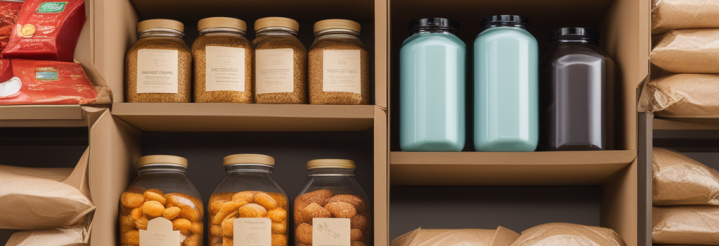This complexity is aptly addressed in the article titled "Sustainable food packaging: An updated definition following a holistic approach," authored by scholars from various European universities. This work underscores the necessity of adopting a holistic perspective when discussing and defining sustainable food packaging.
The article likely delves into the multi-faceted aspects of sustainable packaging, analyzing the entire lifecycle of packaging materials, their environmental impacts, and the roles of different stakeholders in the supply chain. It probably also discusses the challenges of aligning various definitions of sustainability, the importance of considering both the direct and indirect impacts of packaging solutions, and the need for a balanced approach that considers environmental, economic, and social factors.
The article emphasizes the current challenges in universally defining sustainable packaging, noting a lack of common acceptance and usability of existing definitions. The article identifies 38 terms related to sustainable packaging, categorized into four clusters: Sustainable, Circular, Bio, and Other Sustainable Packaging. The study utilizes systematic review analysis and controlled expert feedback to propose an updated, simple, and coherent definition of sustainable food packaging that is specific to the food packaging domain and understandable by all stakeholders.
Key Findings:
Diverse Definitions and Terms: The plethora of terms and definitions in literature leads to confusion and inconsistent practices in sustainable food packaging.
Critical Role of Packaging: Packaging is essential for food safety and quality, impacting its environmental footprint. The complexity of packaging requirements for different food products adds to the challenge of achieving sustainability.
Multidisciplinary and Holistic Approach Needed: A comprehensive approach that considers the entire life cycle of the food-packaging unit and incorporates perspectives from various disciplines is necessary.
Consumer Awareness and Regulation: Limited consumer knowledge and unclear regulations contribute to challenges in sustainable packaging adoption and greenwashing risks.
Balancing Act: Achieving sustainable packaging is a complex balancing act, considering various environmental, social, and economic factors.
Updated Holistic Definition: The article proposes a new definition of sustainable food packaging, emphasizing a balanced, quantified, and validated approach that considers the entire value chain and lifecycle of the food product-package unit.
The article highlights the importance of a clear, universally accepted definition of sustainable food packaging to facilitate informed choices by stakeholders, including consumers, producers, and legislators. It calls for an interdisciplinary approach to address the diverse challenges and complexities inherent in sustainable food packaging.
Proposed definition: Sustainable food packaging is an optimized, measured (quantified) and validated solution, which takes into consideration the balance of social, economic, ecological and safe implementations of the circular value chain, based on the entire history (life cycle) of the food product-package unit.
Although the comprehensive definition of sustainable food packaging was initially tailored for the food industry, it can be adapted with minimal adjustments for other sectors. This definition encompasses a balance between minimizing resource use, such as the wise utilization of available ecological resources and avoiding excess consumption, while addressing both direct and indirect environmental effects. It covers all facets of the food-packaging system and meets the needs of every participant in the supply chain, aiming for efficiency, effectiveness, cyclicality, and safety. Moreover, the production process should prioritize renewable resources, utilizing land and water without displacing food and feed resources. This all-encompassing approach is crucial for considering food safety and packaging functionality, engaging consumers as vital contributors to realizing the intended design.
The analysis underscores the need to expand and refine sustainable packaging metrics and spur further discussions in upcoming studies. Measurement is a vital component of this definition, yet specific metrics are not provided here. Various sustainability assessment methods, such as Life Cycle Assessment (LCA) and the Ellen MacArthur Circularity Index, exist in a dynamic and evolving landscape. While sustainability measurement is not yet standardized and remains a subject of debate, establishing systems for comparing solutions as they emerge is essential. A unified definition and a standard evaluation method are needed to eliminate vague, confusing, or misleading sustainability claims. Given the existing issues with skewed Environmental, Social, and Governance (ESG) reporting due to vague assessment frameworks, research and terminology should be based on rigorously measured data with clearly defined goals, metrics, and research frameworks.
Choosing the right material and designing suitable packaging solutions are important, but it's equally crucial to educate and communicate with end-users to ensure proper usage and disposal of packaging. If challenges like infrastructure are not addressed, and unless there is a concerted effort to establish harmonized policies, the rates of compostability, recyclability, and reuse of food packaging will remain limited. A consumer-centric approach is vital in preventing packaging materials from becoming litter or waste.
Sustainable food packaging is a complex and contextual process, requiring ongoing validation. It's not always the perfect solution and often requires balance and compromise. Food product designers, scientists, and packaging professionals share a social responsibility to seek the best possible solutions, even when they are challenging, costly, or necessitate organizational changes, as part of the broader effort to achieve global sustainability goals.
For a complete understanding and in-depth analysis, it's advisable to refer directly to the original article, which can be found at the provided link. This would offer detailed insights into the nuances and intricacies of sustainable food packaging as outlined by the academic experts. Frontiers | Sustainable food packaging: An updated definition following a holistic approach (frontiersin.org)
Thomas Walther
Corporate Strategy & Innovation Baumer hhs

